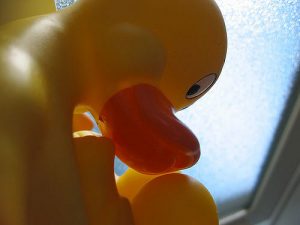Is a dark secret lurking inside those bath-time floaty fowls, the rubber duck?
Your very own cute rubber duck could be harming your child right now, and it’s quackers how they do it.
A study in Switzerland found that 8 in 10 well loved rubber ducks contained potentially harmful bacteria. The toys contained between five million and 75 million bacteria cells per square centimetre. Fungi was growing in 6 in 10 of the toys used in the study.
The causes
Promoted by bath users, diverse microbial growth provides ideal conditions for the formation of bacterial and fungal biofilms – for example, on shower curtains or behind cabinets. This applies in particular to rubber ducks and other bath toys. A murky liquid will often be released because of the dense growth of bacteria and fungi inside the toys.

Not so ducky.
Ditch the duck?
Although rubber ducks are the biggest culprits in this case, they are not the only cause of harm. Bath toys are made from polymeric materials, this is the material that causes the buildup of bacteria. The flexible plastic material absorbs some organic matter, enabling bacteria and fungi to grow.
The study added that this was a fundamental characterisation study of such bath toy biofilms. However, to determine the risk that rubber toys could have, there is much more work to be done.








